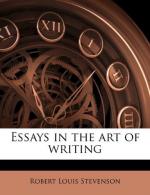Style is synthetic; and the artist, seeking, so to speak, a peg to plait about, takes up at once two or more elements or two or more views of the subject in hand; combines, implicates, and contrasts them; and while, in one sense, he was merely seeking an occasion for the necessary knot, he will be found, in the other, to have greatly enriched the meaning, or to have transacted the work of two sentences in the space of one. In the change from the successive shallow statements of the old chronicler to the dense and luminous flow of highly synthetic narrative, there is implied a vast amount of both philosophy and wit. The philosophy we clearly see, recognising in the synthetic writer a far more deep and stimulating view of life, and a far keener sense of the generation and affinity of events. The wit we might imagine to be lost; but it is not so, for it is just that wit, these perpetual nice contrivances, these difficulties overcome, this double purpose attained, these two oranges kept simultaneously dancing in the air, that, consciously or not, afford the reader his delight. Nay, and this wit, so little recognised, is the necessary organ of that philosophy which we so much admire. That style is therefore the most perfect, not, as fools say, which is the most natural, for the most natural is the disjointed babble of the chronicler; but which attains the highest degree of elegant and pregnant implication unobtrusively; or if obtrusively, then with the greatest gain to sense and vigour. Even the derangement of the phrases from their (so-called) natural order is luminous for the mind; and it is by the means of such designed reversal that the elements of a judgment may be most pertinently marshalled, or the stages of a complicated action most perspicuously bound into one.
The web, then, or the pattern: a web at once sensuous and logical, an elegant and pregnant texture: that is style, that is the foundation of the art of literature. Books indeed continue to be read, for the interest of the fact or fable, in which this quality is poorly represented, but still it will be there. And, on the other hand, how many do we continue to peruse and reperuse with pleasure whose only merit is the elegance of texture? I am tempted to mention Cicero; and since Mr. Anthony Trollope is dead, I will. It is a poor diet for the mind, a very colourless and toothless ‘criticism of life’; but we enjoy the pleasure of a most intricate and dexterous pattern, every stitch a model at once of elegance and of good sense; and the two oranges, even if one of them be rotten, kept dancing with inimitable grace.




